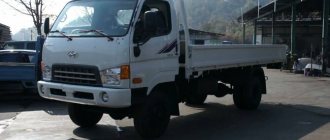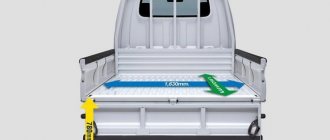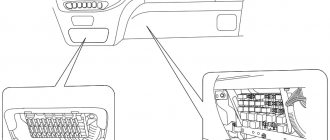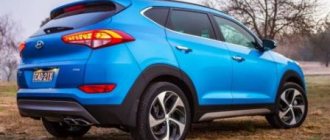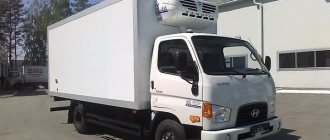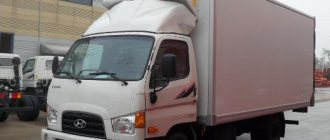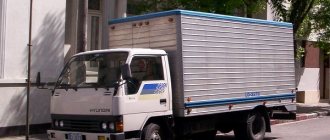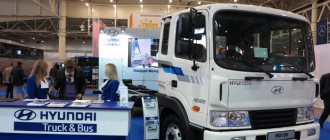According to its technical characteristics, the Hyundai County bus belongs to the intermediate category of passenger cars, located between minibuses and middle-class equipment. The car appeared in the production program of the South Korean plant in 1998, replacing the Chorus model cars, which were descendants of Japanese buses based on Mitsubishi Fuso. Since 2006, the installation of Kauti cars from imported components has been carried out in Russia; in different years, buses have been assembled in Taganrog and Kemerovo.
List of internal combustion engine modifications
D4DD is represented by only one version.
It is worth noting that it has a younger brother D4DB with a volume of 3.9 liters, their differences are minimal. The D4DB is distinguished by a mechanical fuel injection pump, and its environmental class is lower - EURO 2. The engine line also includes a unit labeled D4AL - a diesel “four” with a volume of 3300 cc. and a power of 115 horsepower. Engine Specifications
| Production | Hyundai |
| Engine make | D4DD |
| Years of manufacture | 2008 - n.d. |
| Cylinder block material | cast iron |
| Supply system | injector |
| Cylinder head | OHV |
| Number of cylinders | 4 |
| Valves per cylinder | 2 |
| Piston stroke, mm | 115 |
| Cylinder diameter, mm | 104 |
| Compression ratio | 18 |
| Engine capacity, cc | 3907 |
| Engine power, hp/rpm | 140/2900 |
| Torque, Nm/rpm | 300/1600 |
| Fuel | diesel fuel |
| Environmental standards | Euro III |
| Engine weight, kg | 331 |
| Fuel consumption, l/100 km | 12 — 20 |
| Cooling system | forced |
| Engine oil | 10w40 |
| 15w40 | |
| How much oil is in the engine, l | 8.2 |
| Cylinder operating order | 1-3-4-2 |
| Turbine | Yes |
| Oil change carried out, km | 10000 is better than 7500 |
| Oil consumption, ml/100km | up to 500 |
| Engine life, thousand km | |
| - according to the plant | n.d. |
| - on practice | 400+ |
| Tuning | |
| — potential | n.d. |
| - without loss of resource | n.d. |
| The engine was installed | Hyundai County |
| Hyundai HD | |
| Hyundai Mighty |
Engine for Hyundai HD 65/HD72/HD78/120 (SD)
The Hyundai HD 65/72/78 commercial vehicle is equipped with a 3.3-liter turbocharged diesel power unit. In its line of engines it is considered a model of reliability and maintainability. When operating heavy commercial equipment, which must be in good condition at all times, it is important to install only high-quality original Hyundai spare parts. What can go wrong and why the engine fails. The main reason why your engine may fail is the use of low-quality lubricants or original filters of dubious quality. Using questionable parts may result in a major overhaul of the HD engine in the long run.
Selling Hyundai HD D4AL, DB, DD engine: how to make the right choice during a major overhaul.
A lot of products from various European, Korean and Chinese manufacturers have appeared on the market of auto components for Hyundai HD cars. When carrying out repair work on the engine and replacing spare parts such as: connecting rods, pistons, piston pins, drive belts; cooling fan belts, alternator belts, hydraulic booster belts, air conditioning belts, drive belt rollers, piston ring sets, engine sensors, cylinder block assemblies; We recommend using original components for cylinder head gaskets of all possible thicknesses, turbocharger gaskets (metal), all seals, crankshafts, camshafts and even complete engines (with all the necessary attachments).
Hyundai HD Engine Store: the best choice for you and your car.
Our company has been selling spare parts for Hyundai HD for more than 10 years, the company's range includes more than 50,000 types of spare parts for all groups, suspension, electrical, body parts, engine components, turbines, gaskets and much more. We offer to buy all the necessary components in one place at a competitive price. Any purchase can be made on our website using the Hyundai HD catalog with illustrated images of the products. If you are in doubt about the choice of spare parts or a specific item, please contact a consultant who will accurately select the necessary products and, if necessary, arrange fast delivery. The logistics department of Diesel Parts is able to deliver the purchased engine to any point in Russia in a matter of days.
Subaru 2.0D
Engine Nissan YD25DDTi
Short description:
— 4-cylinder
— 16-valve
— Common Rail power system
— turbocharging
- for compact and mid-class passenger cars and SUVs
Subaru's first diesel engine, designated EE20, is also the world's only boxer diesel engine. This arrangement of the cylinders allows vibrations to be naturally eliminated without requiring shaft balancing. The designers were forced to apply a number of new solutions to make the boxer diesel fit in the engine compartment. The power unit has a unique block design with elements made of aluminum and cast iron, special shortened injectors and a turbocharger located in a non-standard location - in the lower front part of the engine. Currently, the second generation EE20 is being produced, meeting Euro 5 standards.
Operation and typical malfunctions
Premature wear of the dual-mass flywheel
Most likely, it can be argued that premature wear of the dual-mass flywheel and clutch is a defect. The cure for this problem is to configure the controller to produce a lower torque from the engine.
Crankshaft cracking
In engines produced in 2008-2009, cases of destruction of crankshafts and their supports were recorded.
No substitutes
The biggest drawback is the lack of cheap replacement parts.
Technical specifications Subaru 2.0D
| Version | 2.0D - 147 |
| Injection system | Common Rail |
| Working volume | 1998 cm3 |
| Cylinder arrangement/number of valves | B4/16 |
| Maximum power | 147 hp/3600 |
| Maximum torque | 350 Nm/1600-2400 |
| Timing drive | chain |
Application of 2.0D engine
Subaru's only diesel engine inevitably found its way into most models
Subaru Impreza III: from 01.2009
Subaru Forester III: 09.2008-12.2012
Subaru Forester IV: from 03.2013
Subaru Legacy IV: 02.2008-02.2010
Subaru XV: from 03.2012
Rating: ☆☆
The Subaru diesel deserves positive reviews due to its characteristics. However, the lack of replacements, problems with the double flywheel and the destruction of the crankshaft negated all its advantages.
Alternative
Eating more, but much more reliable, gasoline engines are a good alternative.
Conclusion
The engines of Japanese cars are less prone to malfunctions than European cars. Of course, as complexity increases, so does the likelihood of defects. But in the case of Japanese engines, the probability does not increase as much as in European ones. The other side of the coin is the availability and prices of spare parts. Here the Japanese are already losing to the Europeans.
Interior and exterior
The bus is equipped with an all-metal carriage-type body. The power unit is located next to the driver’s seat, covered by a hood with a sound-proof coating. Inside the passenger compartment there are 1- and 2-seat seats for passengers. Along the rear wall there is an additional row of seats for 4 people. The seats are upholstered in soft material and equipped with inertial seat belts. But the design of the seats is not intended for traveling long distances.
Passengers enter the bus through 1 or 2 folding doors (depending on the modification) located on the right side of the body. For the driver there is a separate hinged door on the left side of the car. A separate heater is used to heat the bus interior; some vehicles were equipped with autonomous heaters. To reduce the load on the driver, a hydraulic power steering is used, driven by a separate pump mounted on the engine. The steering column is adjustable for tilt and reach.
The bus is equipped with a panoramic windshield; the end edges of the body are smoothed to reduce aerodynamic drag. The side double-glazed windows are glued into the body openings, and there are sliding ventilation windows. To ensure comfortable conditions in the summer, an air conditioner is used with a compressor driven by the engine crankshaft. There is a 3-position lifting hatch on the roof, which is used to evacuate passengers in the event of an accident.
Fault overview
Engine Hyundai D4FA
D4DD is a very reliable unit. But no one is immune from constructive miscalculations.
D4DD rarely causes problems for its owners. Most often, malfunctions occur due to careless handling of the engine. If you perform maintenance on time and do not overload the motor, then most problems can be avoided. Typical malfunctions and methods for eliminating them:
- The most common problem is a frozen crankcase ventilation valve. This problem was first encountered in the winter of 2009. When the temperature drops below -10, the condensate that has accumulated in the metal tubes that connect the valve to the turbine freezes. The solution to the problem is to remove the valve; in addition, you need to plug the hose going to the oil pan. This will help get rid of this problem.
- Turbine failure is also not uncommon. Most often this occurs due to cartridge wear. It occurs due to dust entering through the air filter. As practice shows, car enthusiasts rarely monitor the condition of filter elements. The worst case scenario is that oil gets thrown into the intake; in large quantities, the lubricant can act as fuel for the diesel unit. Simply put, the engine can go haywire.
- Oil consumption at high mileage. This problem occurs in almost everyone; in most cases, replacing the valve stem seals will help. If after repairing the cylinder head the fault does not go away, it is recommended to overhaul the engine, otherwise oil will begin to enter the combustion chamber. There is a risk that the engine may break down, after which there will be nothing to repair.
- Malfunction of fuel injectors. This problem can be easily identified by the following signs: uneven engine operation;
- knocking in the cylinders;
- increased engine heating;
- drop in power plant power;
- black exhaust;
- increased fuel consumption.
Engine tuning options
Engine Toyota 2NZ-FE
Plugged by factory settings to 112 hp. With. the D4EA engine will be able to return 300 Nm of torque and 140 hp. p., if you perform chip tuning:
- purchase of Galletto1260 for ECU firmware version EDC15C2 or EDC15C7;
- purchasing the tailoring itself from the ADACT community;
- uploading software control to the on-board computer.
Tuning D4EA
Thus, the D4EA in-line turbodiesel has a power of 140 hp. s., which on some cars of Korean manufacturers is suppressed up to 112 hp. With. The engine is installed on crossovers and SUVs; by default it has turbo lag at low speeds.
Modifications
In total, the model is sold on the Russian market in two available modifications, which differ from each other in the difference in wheelbase and length of the bus. Accordingly, their seating arrangements are different.
The first modification has a wheelbase of 3350 mm and a total bus length of 6350 mm. This is a standard modification. The second modification is an extended version, where the distance between the axles is 4085 mm, and the total length of the bus increases to 7085 mm.
The first modification can have 14 to 18 seats if you order a city shuttle bus and 24 seats if you take a Hyundai for “intercity”.
The long-wheelbase modification has the following configurations: 19, 24, 26,28 and 29 seats.
In any configuration, Hyundai County is equipped with two doors: one is standard in the middle, the second is emergency at the rear. But optionally, you can replace the rear door with a standard one, which will significantly speed up the process of loading and unloading passengers.
